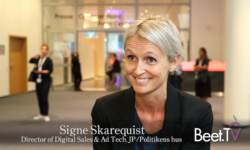COLOGNE – For traditional publishers, the biggest challenge when producing video content isn’t lack of demand. “There is definitely demand there. The biggest challenge for video is actually having enough premium inventory,” says Emma Newman, VP of UK operations for PubMatic.
Driving scale for video is best done via programmatic ad sales, Newman explains in this interview with Beet.TV at the recent DMEXCO 2018 conference in which she also discusses the hurdles that are curtailing the growth of in-app advertising.
Because a majority of video content doesn’t represent significant scale, it’s typically sold directly by in-house sales staff. The challenge to achieving scalability for programmatic is having enough content and inventory, which entails choices.
“Do I put my video content not just on the home page but also in article pages for example? Or do I do some kind of content distribution deal where there’s a potential revenue share, so a publisher who has a similar audience to mine can license my video content, or maybe take my video content” and share the ad revenue it generates.
Quipping that it’s been “the year of mobile forever,” Newman believes apps are the growth area, but with limitations. PubMatic’s new Quarterly Mobile Index, based on clients’ traffic and spend, shows “year over year that app is the growth area both in inventory but also in spend. But I still think there’s a way to go for the spend to catch up to where the eyeballs are.”
Transparency is a key reason why brands haven’t fully embraced in-app ads even though they know that’s where their target audiences are. Newman calls the ads.text initiative “fabulous by the way, we totally support it” but it’s only applicable now to desktop and the mobile web.
“We’ve educated buyers to buy ads.txt so they’re very comfortable with that, but then you say ‘could you buy this in-app traffic as well’ and they’re like, ‘where’s the ads.txt file?’ There isn’t one yet.”
She believes the industry is catching up in the form of the IAB’s SDK. Then there is ads.cert, but it requires open RTB 3.0 integration “so that’s going to take some time to move. So I would say that comfortably in-app is definitely making some changes but there’s a lot of work around education.”
Further complicating in-app progress is the need for a consent management platform per the new GDPR regulations in the European Union, according to Newman.
As for publishers and their “frenemies” status with platforms like Facebook and Google, Newman points to joint ventures by publishers to take back control, among them The Ozone Project in the UK. Launched three months ago, it facilitates ad buying from The Guardian, News UK and Telegraph from one site, as The Guardian reports.
Publishers’ goal is to compete with the scale that advertisers enjoy with social media platforms “in a brand-safe, high-quality environment which also benefits us as publishers because we’re investing a lot of resource into developing this great content that brands actually want to be seen alongside,” Newman says.
This video is part of a series produced at DMEXCO 2018 in Cologne titled: “Finding Success in a Time of Transformation.” It is presented by PubMatic. For segments from the series, please visit this page.





































